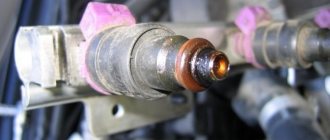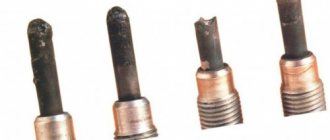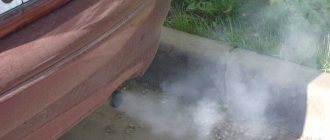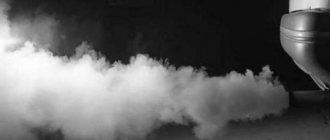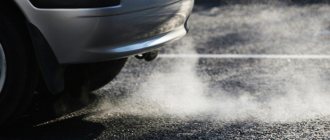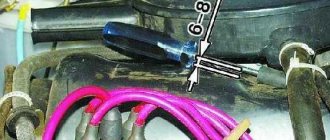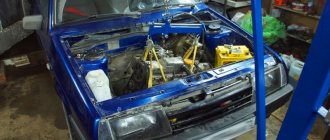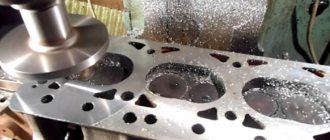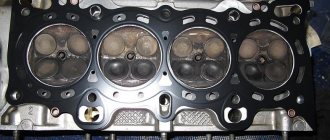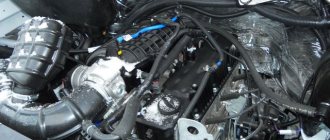Determining the exact cause
Often the cause of engine smoke is a breakdown of the electronic system for controlling proper fuel combustion. Failure of any sensor included in this system leads to chaotic injections of both fuel and oxygen. Also, the main reason for engine smoking is improper formation of the air-fuel mixture.
The lack of air supply is mainly due to contamination of the engine air filter or clogged air ducts. On the electronic systems side, sensors for the amount of air supplied may fail. Almost all sensors of this type cannot be repaired and must be replaced with new ones.
If the blackness of the exhaust increases sharply with engine speed, it is necessary to diagnose the high pressure fuel pump (HPF). Its operation is affected by a leak in the entire fuel line and intercooler. The obvious cause will be oil leaks at the joints with clamps or cracks in the hoses.
To check the tightness, you can use any household pump (bicycle, car) to create an imitation of high pressure. To do this, you need to disconnect the hoses that go to the turbine and the intake manifold, close them on both sides and create pressure using a pump. If there is a leak, it will either be visible or the sound of air escaping.
Eliminating black smoke from the exhaust pipe
The simplest solution is to simply replace the filters. If replacement does not help, you should pay attention to the condition of the fuel injectors.
The main reason for failure of fuel injectors is poor quality of diesel fuel. Externally, a malfunction of the injectors is expressed in the appearance of thick smoke when driving with a load or attempting to accelerate quickly. At the same time, noticeable vibration from the engine is transmitted into the cabin.
Sometimes the cause is an early fuel injection angle, as a result of which the air-fuel mixture ignites with a long delay, which leads to the creation of increased pressure in the working cylinder. As a result, the mixture does not burn completely and a large amount of carbon turns into black soot, which is thrown into the exhaust pipe.
If, as a result of diagnostics, the injection angle is correct and the fuel quality meets the standards, then repair of both the injectors and the injection pump will be necessary.
Another reason for black smoke from a diesel exhaust pipe
One of the owners of a diesel car suddenly began to smoke. During the autopsy, nothing intelligible could be found. But after reading all kinds of forums and talking with other diesel owners, it turned out that the problem was in the ignition.
After opening it again, a control valve was found on the ignition unit. He was advised to hit the adjusting bolt. After that the car stopped smoking. It turned out that it was the ignition angle solenoid valve.
When the ignition is turned on, a working sensor crackles. What to do if black smoke appears from the exhaust pipe (diesel)? No matter what ignition it appears, the sensor should be removed. If the engine has stopped smoking and the car is running smoothly, then it’s time to change this element.
Turbocharger malfunctions and compression problems
Modern diesel engines are equipped with turbochargers, which has given them widespread use in passenger cars for everyday use. This also added another reason for the smoking engine.
This is either an increased amount of oil entering the intake tract due to wear of the rubber seals, or the turbine for some reason is not able to pump up the required pressure. If the engine has low compression, then there are problems with starting the engine, a noticeable loss of power and the appearance of thick black smoke under load.
A very rare reason why a diesel engine smokes black smoke is excessive compression. The sound of the engine and the noise of fuel detonation can be clearly heard in the cabin. This defect appears when there are errors during the assembly of the entire motor as a whole. The high smoke content of a diesel engine itself does not lead to engine failure.
But if the cause is an incorrectly set injection angle or gradual failure of the injectors, then driving such a car will lead to the destruction of engine parts from the increased load. The end result will be the need for a major overhaul or complete replacement of the unit, which is a very expensive procedure for diesel engines.
Blue smoke
The appearance of blue exhaust gases causes panic among drivers. This means a number of malfunctions in the engine; the problem can be diagnosed by looking at the smoke produced.
If the exhaust is a distinct blue color, then the fuel jet is ineffective, the fuel does not burn, but is discharged in the form of droplets through the muffler. Warming them up gives a blue color, but there is a more global problem - the main mixture burns not in the air space of the compression chamber, but on the bottom.
Interesting! At this rate of work, the piston burns, damage appears on the cylinders, leading to expensive repairs.
Blue exhaust means that diesel fuel is difficult to ignite. The reason for this is insufficient compression, which manifests itself due to wear of the cylinder-piston group. In addition, the lack of pressure can be explained by the fact that the valve plates do not fully adhere to the seats due to carbon deposits. The second reason is the malfunction of the glow plugs; they simply do not provide the temperature for ignition.
With other color variations with different shades of blue, it is possible to diagnose oil penetration into the cylinders and its combustion. This fluid should not be in the cylinders, but it can appear there through:
- engine crankcase with worn out or jammed oil scraper rings;
- worn valve stem seals that allow oil to leak from the valve box;
- seals in bearings installed in the turbine;
- air filter due to clogged crankcase ventilation.
If the engine is running with thick black, blue or white exhaust, diagnostics should be started immediately. The most common causes are malfunctions of the fuel pump, ignition system, and breakdowns in the air ducts.
Over time, the engine may completely fail if repair measures are not taken. To do this, it is better to contact the experts. They will carry out an accurate diagnosis and will repair and care for the car, eliminating not only the smoking exhaust, but also the cause of the malfunction.
Rare case
Sometimes even a long diagnosis does not reveal the cause of black smoke from a diesel engine. In this case, it is worth inspecting the ignition mechanism. Some engine models are equipped with a valve that controls the operation of the ignition unit. The operating torque of such a unit is adjusted using a bolt on the body. Such blocks are built on the electromagnetic principle of regulation.
You can check the functionality of such installations by sound (a working sensor will begin to crackle), or disconnect it from the system. If this manipulation improves engine operation and the smoke disappears, this is an indication to replace the element.
Consequences of soot formation
With increased soot formation in a diesel engine, the diesel particulate filter is usually the first to fail, which leads to the need to replace it. Subsequently, the soot gets into the oil, which circulates throughout the engine. The oil channels quickly become clogged, which is why the oil cannot effectively remove heat from engine parts and they overheat.
First, plaque forms on the piston rings (they become coked). Then all the filters installed in the car quickly become clogged with dirt and lose their properties.
Reducing the flow of fuel channels reduces the amount of incoming oil to lubricate parts, which is why they are subject to increased wear. Operating the engine at elevated temperatures will eventually lead to burnout of valves and pistons. Replacing these parts is one of the most expensive procedures when servicing a car.
When mixing fuel and engine oil, the viscosity of the latter is greatly reduced and in this state the oil is not able to protect parts from wear during operation. This can be determined visually by removing the oil dipstick from the engine. If, even at subzero temperatures, engine oil drips from the dipstick and smells like diesel fuel, this is a direct indication of the need for urgent repairs.
Soot formation and consequences
When black diesel exhaust smoke appears as a result of malfunctions of the high-pressure fuel pump, diesel injectors, as well as in the absence of an optimal injection advance angle, increased soot formation occurs. The diesel particulate filter suffers from its excess amount. Soot also penetrates into the engine oil and quickly contaminates the engine. There is a violation of heat exchange, the piston rings quickly become coked, and the filters become clogged.
Blockage of the oil channels of the internal combustion engine leads to a decrease in pressure in the lubrication system and increased wear of engine parts. Impaired thermal conditions can cause burnout of both pistons (CPG) and valves (GRM). Excess unburnt fuel enters the engine oil through such burnouts. The fuel in the oil immediately reduces its viscosity, the lubrication becomes ineffective, and the anti-wear properties of the additives in the engine oil are lost.
The problem is diagnosed by analyzing the condition of the engine oil. It is enough to remove the dipstick and look at its viscosity. If the oil in a diesel engine is very liquid and drips heavily from the dipstick even in cold weather, and also has a persistent smell of diesel fuel, then the problem must be repaired immediately. An increase in the oil level also directly indicates that fuel has entered the engine crankcase.
Parts of the cylinder-piston group come under attack. The cylinder walls are the first to suffer, as diesel fuel washes away the oil, resulting in scuffs appearing on the cylinder surface. Wear on other engine parts also increases greatly. Operating a diesel engine with this malfunction is problematic, and further driving will quickly destroy the internal combustion engine completely, requiring a major overhaul of the diesel engine.
Common causes of smoke
As you know, the fuel-air mixture burns in the engine cylinders. The fuel enters here through the injector nozzles and “meets” the air, which is supplied through the intake manifold. The cylinder pistons create the pressure necessary to mix air with fuel. When the entire system works like a clock, the mixture burns almost completely, and the emission of hydrocarbons into the atmosphere is minimal. The smoke that comes out of the exhaust pipe when the engine starts is the result of incomplete combustion of the fuel mixture for various reasons:
- The injection advance angle is off.
- Uneven fuel spray.
- Insufficient air supply to the cylinder block.
- Fuel is of low quality, with a high concentration of sulfur.
Let us immediately note that it is impossible to find out the exact cause of the breakdown only by the type of exhaust. The color of the smoke will tell you where to look for a problem (cooling system, compressor, etc.), which will save time. But an accurate “diagnosis” will only be made by a complete diagnosis of all systems, which is best not to delay.
Black smoke from Cummins engine
Cummins, like other diesel engines, smokes black most often due to incomplete combustion of fuel in the cylinders. The black color of smoke is actually caused by soot—unburned fuel elements. For fuel to burn properly, the correct mixture of oxygen and fuel is necessary. Too much or too little of one or the other results in thick black smoke coming out of the exhaust pipe.
A larger volume of fuel in the cylinders than necessary is a consequence of:
1) malfunction of the injectors, in which the spray needle is most likely jammed;
2) incorrect adjustment and breakdown of the high pressure fuel pump;
3) malfunction of the fuel injection pump actuator (fuel dispenser);
4) the rarest but possible option is a malfunction of the internal combustion engine control module.
Black smoke is usually accompanied by increased fuel consumption, starting problems (sometimes only from a tow), and loss of power. Faulty injectors often make themselves known by a metallic knock. And the engine does not start because faulty injectors drain too much fuel into the return line (into the tank). If the injectors are leaking, we strongly recommend that you stop using the engine. Otherwise, due to the very high temperature in the cylinders, the pistons may simply melt. And this is a completely different cost of repair.
As for the lack of air in the mixture, its causes must be sought in the engine intake system. Causes:
- Clogged air filter
- Malfunction of the EGR valve or throttle (applies only to Euro 4 and Euro 5)
- Incorrect valve clearances or misaligned valve marks
- Turbine malfunction
Black smoke can often be observed during a cold engine start. This is a completely normal phenomenon and is due to the fact that at very low temperatures the fuel is not atomized, but flows into the cylinders. This goes away when the engine warms up.
Black color of smoke: causes and consequences
The black color of the exhaust is due to its high soot content. Most often, diesel smokes black due to the low cetane number of diesel fuel, or, more simply, due to poor fuel quality. Switching to higher quality diesel fuel will help confirm or refute this guess. If after several starting cycles the smoke color remains the same, then the problem is not in the fuel.
Air filter clogged
The purpose of the filter is to clean the air entering the cylinders from solid particles that can damage the engine. When it becomes clogged, the air supply is reduced, which affects engine power and fuel consumption. If the filter is clogged, fuel burns in vain. If you notice increased fuel consumption along with black smoke, check the filter first. In vehicles equipped with an on-board diagnostic system, the computer will display P0171 or P0172.
The solution to the problem is obvious - the air filter needs to be changed. Car manufacturers advise replacing filter elements every 12 months or every 10-20 thousand km. The “life” of the filter largely depends on the operating conditions of the car. On dusty dirt roads it will clog faster than when driving on smooth, clean asphalt.
The injectors are clogged
If a diesel engine smokes black smoke when cold, does not start on the first try, and stalls when you press the gas pedal, most likely the reason is in the injectors. When using low-quality fuel, tar and sludge accumulate in the spray holes. Cleaning them will help restore the functionality of the injectors. There are two ways to flush injectors:
- Chemical. A special cleaning compound (solvent) is poured into the fuel system and the engine is started several times.
- Physical. The injectors are removed from the engine and placed in a special ultrasonic bath. This method is more effective, although more expensive.
Turbocharger faulty
Black smoke from the exhaust pipe with low engine power and increased oil consumption indicates problems with turbocharging. There may be two reasons:
- air duct blockage;
- Intake/exhaust manifold leaking.
You can even diagnose an air leak by ear - when the engine is turned on, the turbocharging system emits a loud, characteristic whistle. If the turbocharger is silent, you need to turn off the engine and check the air path for blockages.
The saddest thing
One of the saddest breakdowns that beset diesel owners is the inevitable wear and tear of the fuel pump. As already mentioned, the guts inside the pump operate without lubrication. While diesel still lubricates something in summer, in winter it doesn’t. And domestic fuel is generally of low quality. This is where the insides of the pump wear out.
When the gas pedal is pressed very sharply, for example, in order to quickly move off, the injection pump lever is switched to increase the volume of fuel supply. This lever will rest on the support. And the position of this very support has already been adjusted by the regulator. Therefore, it will not be possible to increase the volume too sharply. So, by pressing the pedal, the driver only wants to give a larger volume of fuel. And it’s not at all a fact that this will lead to an increase in turnover. This directly depends on how worn the speed controller is. If it is in normal condition, then the car will start with gray smoke. If the wear is large, then the diesel will spit out black smoke from the exhaust pipe in a large cloud.
White color of smoke: causes and consequences
In winter, white exhaust from the pipe when the engine warms up is quite normal. This comes out as water, which is a natural product of fuel combustion. Due to the temperature difference, it condenses and turns into steam, which quickly dissipates.
But if a diesel engine smokes white even when the engine is well warmed up and at above-zero temperatures, this indicates problems with the cooling system. Most likely coolant has entered the cylinder block. Most of it consists of water, which forms thick steam when the fuel-air mixture burns. Liquid penetrates into the block due to depressurization of the cylinders themselves or wear of the gaskets responsible for the tightness of the cylinder head or intake manifold.
To diagnose faults, remove the cylinder head and evaluate the condition of all parts of the system. The entry of water into the fuel-air mixture increases wear of all parts. Repairing the cooling system will cost much less than overhauling the engine. Therefore, it is better not to ignore white smoke when the diesel engine is running hot.
Blue color of smoke: causes and consequences
Oil getting into the cylinders
In this case, the exhaust takes on different shades of blue: from pale blue to swirling whitish blue. The color of the smoke depends on the operating mode and degree of engine warm-up, as well as the concentration of oil that has entered the cylinders.
A simple test will help you check for oil in the exhaust. With the motor running, cover the pipe with a sheet of paper for a few seconds. If greasy drops appear on it, it means that oil has leaked into the combustion chambers. This is possible if the compression rings are worn out or the cylinder surface is damaged due to abrasive particles. If the car has been parked for a long time, pockets of corrosion may appear on the cylinders and compression rings.
The degree of wear of parts can be determined by the color of the smoke. If the blue color of the exhaust only appears when it warms up, wear is still insignificant. If parts are severely damaged, the smoke only increases.
Sometimes a diesel engine smokes blue smoke due to the fact that the oil scraper rings have lost their springiness. Motorists call this phenomenon stagnation. The rings do not fulfill their intended purpose and oil enters the engine cylinders.
Compression drop
You can diagnose a drop in compression in the cylinders of a diesel engine by the thick black exhaust at startup. A large pressure difference leads to unstable operation of the motor. In cold weather, a unit with weak compression may not start at all - there will not be enough temperature to ignite the fuel mixture.
Another cause of blue smoke is burnout of cylinder valves, accompanied by increased oil consumption. The problem can be easily diagnosed by checking the compression in all cylinders - in the damaged one it will be very low. Burnout of the valves is also indicated by an increase in carbon deposits on the spark plugs.
Sometimes the engine smokes blue due to a ruptured regulator membrane in the automatic transmission. The membrane cavity extends into the intake manifold, and when starting, the engine sucks oil from the automatic transmission.
Causes and methods of eliminating black smoke from the exhaust pipe of a diesel engine
The appearance of smoke in engines running on diesel fuel occurs much more often than in gasoline power units. It's all about the principle of fuel ignition. To carry out this process, the air in the diesel engine is heated to 750-800 degrees and pressure is created. In a gasoline engine, ignition occurs from the spark plug. Plus, diesel fuel requires a higher temperature to ignite than light fractions of fuel. Compared to a gasoline engine, in a diesel engine the mixture is formed in a very short time, which leads to its heterogeneity.
Do not forget: in order to burn 1 liter of fuel, up to 15 liters of air are required. Smoke indicates a malfunction of one or more systems at once. There are several reasons for this.
Other causes of smoke in diesel engines
- Malfunction of the CCVV (crankcase ventilation valve). This problem is typical for BMW cars. When accelerating hard, the diesel produces thick white smoke. Replacing the valve solves the problem.
- Engine oil overheating. The problem manifests itself under extreme loads on the engine (full weight load, prolonged ascent) - then thick white smoke pours out of the muffler. The solution is to replace the oil with a higher quality one and not subject the engine to overload.
- Worn or hardened valve seals. The problem is typical for domestic cars with a diesel engine. It manifests itself as an abundant emission of white-blue smoke in the first seconds after starting the engine. As it warms up, the smoke goes away. The solution is to replace the valve stem seals.
Anti-smoke additives - a panacea or a waste?
Various auto chemical brands offer special additives to reduce oil consumption. They form a film on the rubbing parts of the engine that protects them from wear and fills existing microcracks. The use of additives replaces the decoking of piston rings, cleaning them from dirt. Manufacturers promise all this, but is it really so?
On auto forums you can find conflicting opinions about anti-smoke additives. Some auto mechanics note that the use of such products makes it difficult to overhaul the engine. The engine parts are covered with an oil layer, which is very difficult to completely wash off. Individual parts that could simply be cleaned have to be replaced, which means repairs are more expensive.
The additive only slightly extends the life of the engine before repair, but does not guarantee its trouble-free operation.
